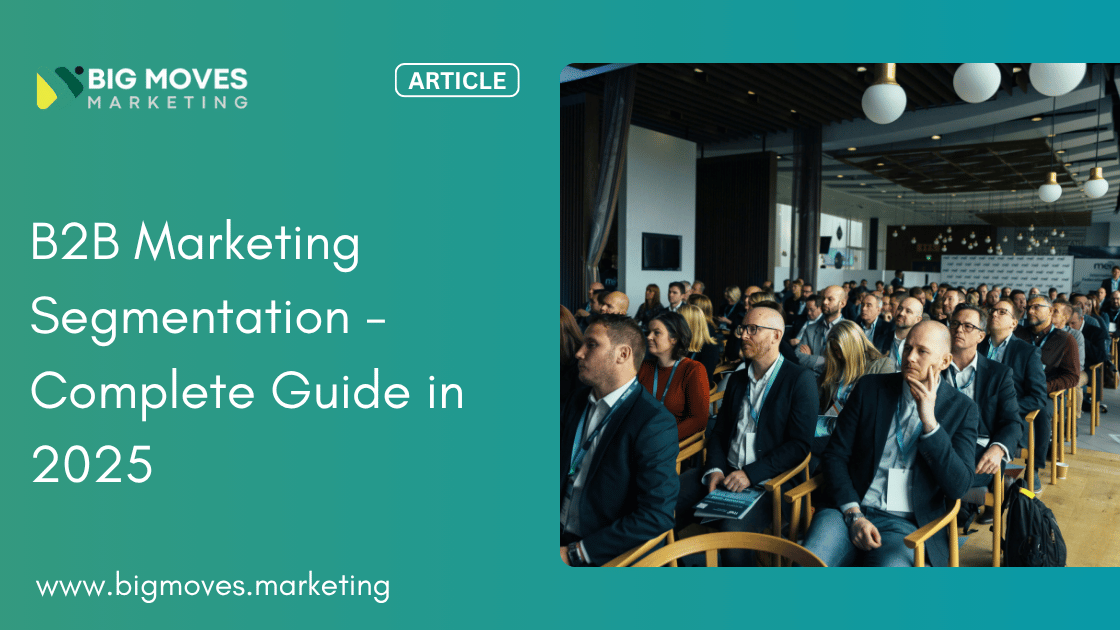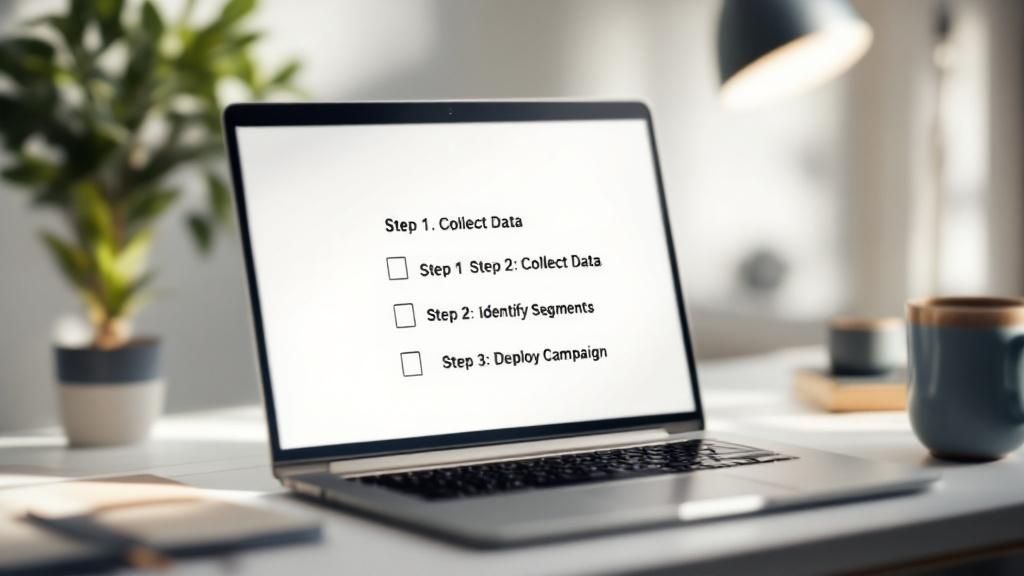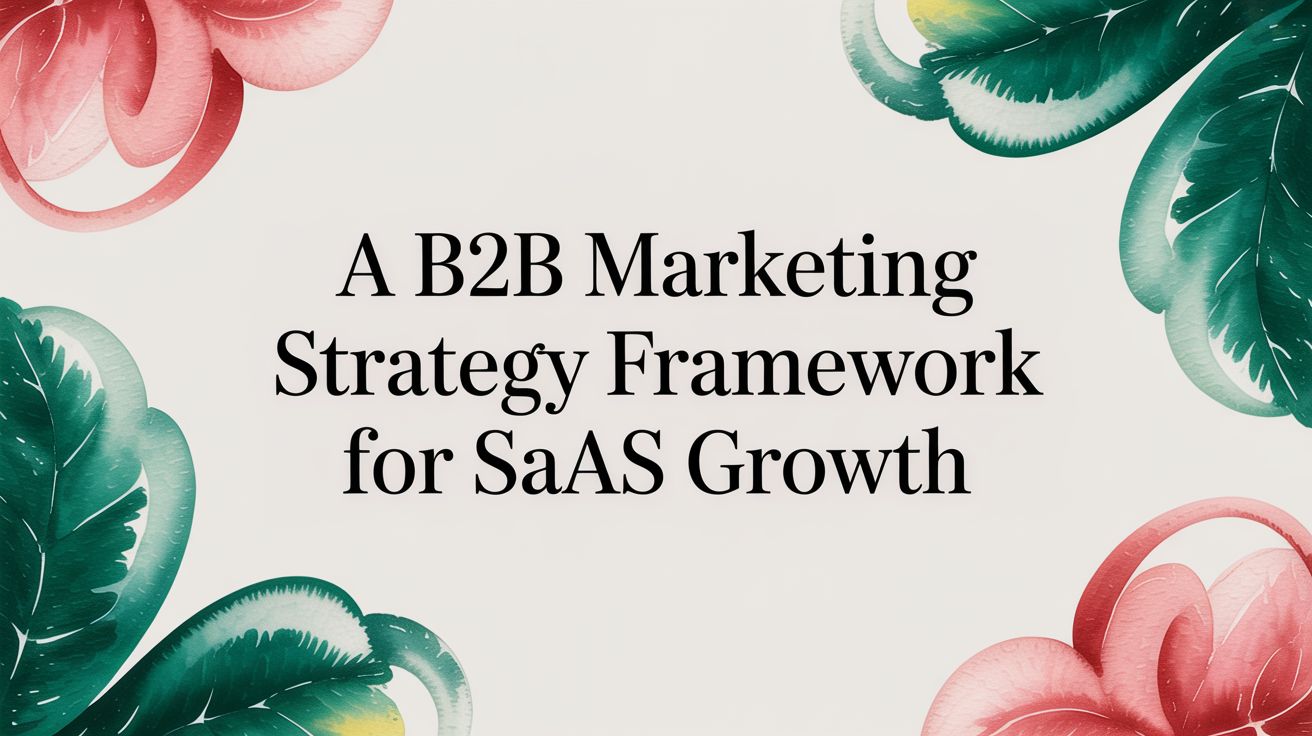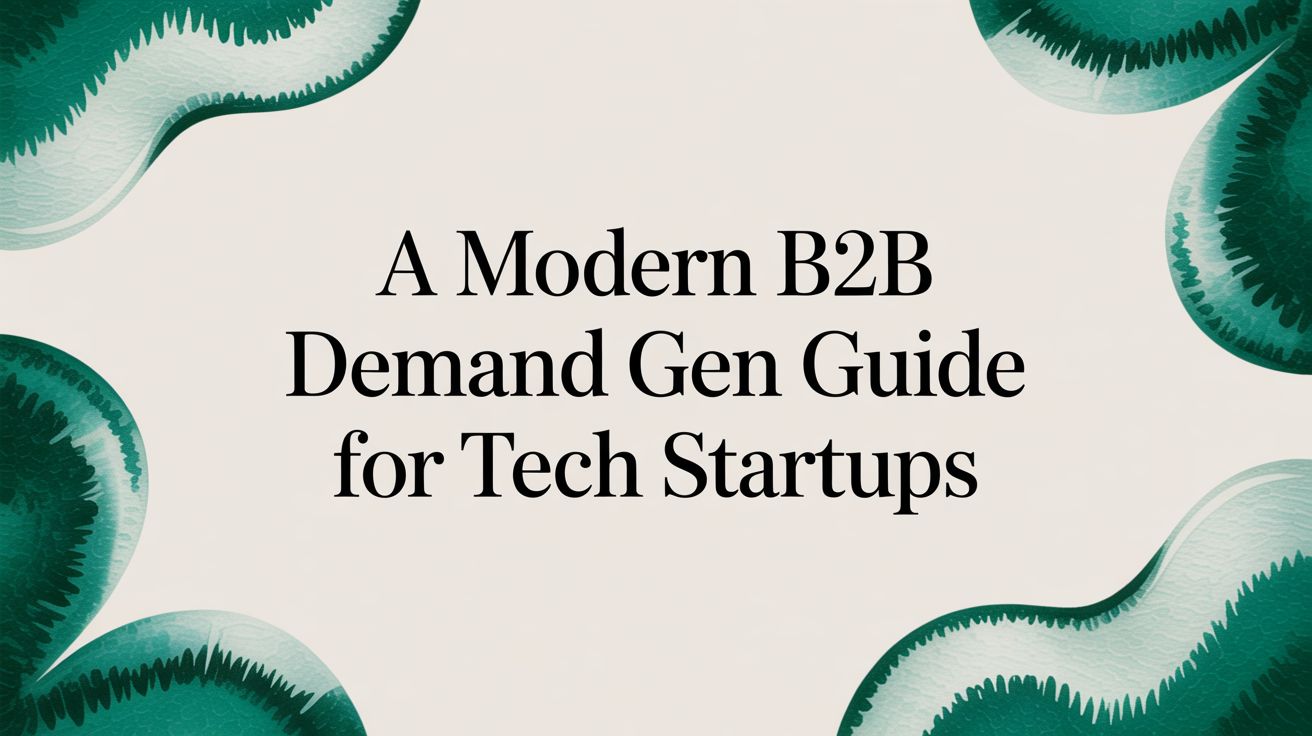B2B Marketing Segmentation - Complete Guide in 2025
August 1, 2025

If you’ve been segmenting your B2B marketing based on company size and industry alone, you’re leaving money on the table. That model is outdated. Real growth today comes from a much deeper understanding of your ideal customers—their motivations, their behaviors, and even the tech they use every day.
This is how you build real relationships and sustainable revenue, not just a glorified list of leads.
A Modern Approach to B2B Marketing Segmentation

In today’s market, a one-size-fits-all approach is a surefire way to burn through your budget. The key to unlocking powerful results lies in B2B marketing segmentation—the strategic practice of dividing your business customers into distinct groups based on meaningful, shared characteristics. It’s how you stop shouting into a void and start having focused conversations that actually lead somewhere.
This isn't about creating extra work; it's about being smarter with your effort. When you know exactly who you're talking to, you can craft messages that resonate, solve problems that matter, and build campaigns that crush their goals. It’s no surprise that companies excelling at segmentation often see a major boost in sales—they’re speaking their customers’ language.
Going Beyond Basic Firmographics
For years, segmentation got stuck on firmographics—the basic details like company size, industry, and location. While that information is still a decent starting point, it only paints part of the picture. True, modern segmentation requires a more layered approach that gives you a complete view of your target accounts.
Think of it like building a complete customer profile with these essential layers:
- Firmographic Data: The "who" and "where." These are the foundational stats about a company, like employee count, annual revenue, and their industry vertical.
- Technographic Data: The "what they use." This is all about the technology stack a company uses, which tells you a ton about their operational maturity and potential integration needs.
- Behavioral Data: The "how they act." This covers how a company interacts with your brand—things like website visits, content downloads, and email engagement. It shows you who’s interested.
- Needs-Based Data: The "why they need you." This gets to the heart of their specific challenges or goals that a solution like yours could solve.
By layering these data points, you move from a flat, two-dimensional view of your market to a rich, three-dimensional understanding. This is where you uncover the why behind every purchase, not just the who.
A quick look at these models can help you decide where to start.
Key B2B Segmentation Models at a Glance

Each model offers a different lens through which to view your market. The real magic happens when you start combining them to build truly nuanced customer segments.
Why Deeper Segmentation Is a Strategic Imperative
When you adopt this more advanced segmentation mindset, you’re not just tweaking a campaign—you’re upgrading your entire marketing engine. Your focus naturally shifts from just grabbing any lead you can get to creating a pipeline of high-quality, engaged prospects who are genuinely a great fit for what you offer. For B2B companies, especially in SaaS and tech, this precision isn't just a nice-to-have; it's absolutely critical for sustainable growth.
This strategic thinking influences everything from product development to customer retention. By understanding the unique needs of different segments, you can tailor your messaging, personalize your outreach, and ultimately build stronger, more profitable relationships.
If you want to explore the core principles further, diving into the fundamentals of effective business-to-business marketing is a great next step. This framework sets the stage for every successful marketing action you'll take from here on out.
Building Your Data-Driven Segmentation Framework
A powerful B2B marketing segmentation strategy isn't built on guesswork; it’s engineered with data. You have to move beyond intuition and embrace a systematic way of understanding your market. The goal here is to build a living, breathing Ideal Customer Profile (ICP) that directs every marketing move you make, ensuring your efforts are precise and impactful.
This whole process kicks off with smart data collection. It’s not about grabbing every piece of data you can find. It's about zeroing in on the specific information that actually drives decisions. To get the full picture, you really need to weave together different types of data.
This infographic lays it out perfectly, showing how the four core data types—firmographic, demographic, behavioral, and technographic—fit together like puzzle pieces.

The real insight here is that no single piece tells the whole story. Real understanding only happens when you see how these data points overlap. That’s when you get the full context of your target accounts.
Sourcing Your Segmentation Data
So, where do you get all this data? It comes from a mix of places, both inside and outside your company. Your own CRM is a goldmine of first-party info, packed with valuable behavioral and historical data. You can then flesh this out by using third-party enrichment tools to fill in the firmographic and technographic gaps, giving you a much richer dataset to play with.
Think about the specific questions you need to answer for each data type:
- Firmographics: What industries do our best customers operate in? What's their typical annual revenue or employee count?
- Technographics: What marketing automation platform are they using? Are they using a competitor's software?
- Behavioral: Which accounts are constantly visiting our pricing page? Who downloaded our latest case study?
Getting answers to these questions forms the foundation of your segmentation. For a deeper look at how this fits into the bigger picture, check out our comprehensive guide on B2B marketing.
A Practical SaaS Scenario
Let's make this real. Imagine you're a mid-sized SaaS company that sells project management software. A basic segmentation might target "tech companies with 50-250 employees." That’s a start, but it's way too broad to be effective.
A truly data-driven framework lets you get much more precise. You might build a high-priority segment that looks something like this:
Segment A: High-Growth Tech Scale-ups
- Firmographics: Technology industry, 50-250 employees, secured Series A or B funding in the last 18 months.
- Technographics: Uses HubSpot for marketing and Salesforce for sales (which tells you they care about integration).
- Behavioral: Multiple people from the same company have visited your "integrations" page and watched a webinar on "Scaling Project Workflows."
This level of detail completely changes your approach. You're no longer marketing to a generic tech company. You're speaking directly to a well-funded scale-up that values integration and is actively looking for a solution to manage its growth.
"Your segmentation framework is your strategic map. It doesn’t just show you who your customers are today; it illuminates the path to acquiring your best customers of tomorrow."
This also shows how modern B2B segmentation is being shaped by major shifts in technology and demographics. For instance, nearly half of all B2B buyers are now millennials—a digital-first generation that expects personalized, research-driven engagement. At the same time, AI is changing expectations, with 34% of B2B buyers in sectors like manufacturing and healthcare looking to AI for process automation.
As you build out your framework, it's wise to incorporate proven email segmentation best practices to make sure your outreach is tailored and effective. This layered understanding—knowing your buyer's generation and their readiness for new tech—is crucial.
By building a framework grounded in these multi-faceted data points, you create a foundation that is not only accurate but also incredibly actionable. It’s the difference between casting a wide, hopeful net and fishing with a targeted, effective spear. That’s the core of a modern, data-driven segmentation strategy.
Turning Segments Into High-Impact Marketing Plays

Defining your segments is a genuine breakthrough moment, but let's be honest—it's just the starting line. The real magic, where all that research pays off, happens when you turn those data-driven profiles into focused, high-impact marketing actions.
This is where your strategy truly comes to life. It's about taking those static personas off the page and engaging them with messaging, content, and experiences so relevant they feel personal. You have to speak their language, hit on their specific pain points, and show up in the channels where they actually spend their time.
Crafting Unique Value Propositions For Each Segment
A one-size-fits-all value proposition is a recipe for being ignored. To actually connect, you have to tune your core message to what each segment cares about most. This isn't just a marketing task; it's an exercise in empathy, grounded in a deep understanding of their unique pressures and goals.
Let's say you're marketing a flexible, all-in-one operations platform. Your pitch needs to change completely depending on who you're talking to:
- For the ‘High-Growth Tech Startup’ Segment: Your value proposition should be all about speed and scalability. You’ll want to focus on how your platform helps them accelerate, integrate with their ever-changing tech stack, and scale without hitting a wall. Think words like "agile," "quick integration," and "future-proof."
- For the ‘Established Enterprise’ Segment: The conversation shifts dramatically. Here, it’s about efficiency, compliance, and risk mitigation. Your value proposition needs to underscore security, process optimization, and proven ROI. You'll lean on terms like "streamline," "secure," and "reliable."
This is more than just swapping out a few keywords. It's a fundamental pivot in how you frame your solution’s value, based directly on what keeps each segment’s leaders up at night.
Your ability to nail a segment-specific value proposition is directly tied to how well you’ve listened to their needs. Don't assume you know. Validate your messaging by talking to real people in each group.
Mastering Your Channel Activation Strategy
Your message, no matter how perfect, is useless if it doesn't reach the right people in the right place. A scattergun approach to channels just burns through your budget and dilutes your impact. Instead, use your segment profiles to pinpoint where your efforts will be most effective.
A focused channel plan is the backbone of your activation strategy. If you're wrestling with where to put your time and money, our guide on building a powerful B2B marketing channel strategy offers a structured way to make those tough calls.
Here’s what this strategic focus might look like in practice:
- LinkedIn: It's a must for almost any B2B play, but how you use it should differ. For your 'Enterprise' segment, you’d share in-depth thought leadership and target senior executives. For the 'Startup' crowd, you might run punchy video ads that showcase quick wins and agility.
- Industry-Specific Forums: If you're targeting a niche vertical like logistics or manufacturing, finding active online communities is like striking gold. These are places for authentic conversation where you can build real credibility, not just drop links.
- Targeted Email Campaigns: With your segments clearly defined, your email marketing can become surgically precise. You can send the 'Startup' segment a case study about a peer company's explosive growth, while the 'Enterprise' segment gets a whitepaper on data security and compliance.
Once your segments are active, using the right tools can amplify your reach and personalization. For anyone looking to scale these tailored interactions, it's worth exploring the latest marketing automation best practices.
An Activation Blueprint In Action
To pull this all together, let’s look at a simple activation plan. The table below shows how you can align your value proposition, content, and channels for our two example segments, creating a clear blueprint for your team.
Sample Activation Plan for Two B2B Segments
SegmentValue PropositionKey Content PiecesPrimary ChannelsHigh-Growth Tech Startup"The agile operations platform that scales as fast as you do."A case study on a peer startup that 2x'd its efficiency. A webinar on "Avoiding Scaling Pains."LinkedIn (video ads), TechCrunch, targeted podcasts.Established Enterprise"The secure, compliant platform for optimizing complex workflows."A whitepaper on data security and ROI. A custom demo focused on risk mitigation.LinkedIn (thought leadership), industry trade journals, executive roundtables.
This kind of blueprint brings clarity and alignment to your marketing efforts. It makes sure every piece of content you create and every dollar you spend is working together to engage a specific, high-value audience.
Ultimately, turning segments into marketing plays is about shifting from analysis to action. It’s the creative, strategic process of translating what you know about your customers into marketing they can’t possibly ignore. This is how you build real momentum, foster genuine connections, and inspire your most valuable customers to make their next big move.
Finding the Right Mix of Brand and Demand
Let's be honest: in the day-to-day grind of hitting lead quotas and proving ROI, brand building can feel like a luxury. It often gets pushed to the back burner in favor of what feels more urgent—generating demand right now. But this creates a dangerous imbalance. Short-term wins start to cannibalize long-term market leadership.
The good news is, you don’t have to choose. Your B2B marketing segmentation framework is the key to breaking this cycle. It's how you stop treating brand and demand as competing priorities and start seeing them as two interconnected engines driving your growth.
With a smart segmentation strategy, you can get the best of both worlds. You can strategically invest in building brand awareness with high-potential segments for your future pipeline while running aggressive, performance-focused campaigns aimed at mature segments ready to buy today.
Using Segments to Guide Your Investment
Think of your segments like a financial portfolio. Some are aggressive growth stocks that need long-term investment (brand), while others are blue-chip assets ready to deliver immediate dividends (demand). This is where a split-funnel approach, guided by your segments, really shines.
Here's how that might break down in the real world:
- Emerging Segments (Brand Focus): These are the companies that perfectly match your ICP but aren’t actively looking for a solution... yet. Your job is to get on their radar. This is where you invest in thought leadership, top-of-funnel social campaigns, and industry partnerships to build name recognition and trust long before they even think about buying.
- Mature Segments (Demand Focus): These are the accounts showing all the right buying signals. They're in-market and actively evaluating solutions. The goal here is simple: conversion. You hit them with bottom-of-funnel tactics like personalized demo offers, competitive comparison guides, and highly targeted ads designed to push them over the finish line.
This dual approach ensures you’re not just harvesting existing demand—you’re actively creating it. You're building a sustainable pipeline that isn't totally dependent on who happens to be searching for you this week.
The Challenge of Measuring Brand ROI
So, why doesn't everyone do this? Because proving the value of brand marketing is notoriously tricky. Demand gen gives you clean, satisfying metrics like cost-per-lead and conversion rates. Brand ROI feels fuzzier, making it a tough sell to a leadership team focused on the bottom line.
This tension is one of the defining challenges in B2B marketing right now. The data tells a fascinating story: 40% of B2B marketers are planning to increase their brand-building budgets, a clear signal they see the long-term value.
At the same time, lead generation is still king, with 58.2% of marketers dedicating at least half their budget to it. While a solid 62.7% of marketers agree brand is critical for long-term growth, proving its ROI remains a massive roadblock. You can dig deeper into this data and its impact on 2025 B2B brand marketing on emarketer.com.
Proving brand value isn’t impossible; it just requires a different set of metrics. You have to shift the conversation from direct attribution to measuring influence and momentum over time.
To get buy-in, you need to arm yourself with the right data. It's about tracking metrics that demonstrate growing brand equity and market presence within your most important segments.
Practical Metrics for Brand Performance
Instead of trying to force a direct lead-attribution model onto your brand spend, focus on tracking these indicators of growing influence and awareness:
- Share of Voice (SOV): Within your target segments, how often is your brand being mentioned online compared to your key competitors? Tools like Brand24 or Meltwater can help you track this. An upward trend is a powerful sign of growing relevance.
- Direct & Branded Search Traffic: Are more people typing your company or product name directly into Google? This is a clear signal that your brand recognition is growing. A steady increase here means your brand activities are working.
- Website Engagement from Target Segments: Using a tool like Clearbit or 6sense, are you seeing more traffic and longer session times from companies that fit your high-potential, brand-focused segments? This shows you're attracting the right audience, even if they aren't converting immediately.
By presenting this data alongside your demand-gen results, you paint a complete picture of your marketing engine. You can show stakeholders exactly how your brand efforts today are warming up the audiences that will become your highest-quality leads tomorrow. This is how you build a powerful B2B brand that doesn't just capture demand—it creates it.
Adapting Your Segmentation for Global Markets
A B2B segmentation model that delivers stellar results in one country can easily fall flat on the global stage. What crushes it in North America might need a complete overhaul for markets in the Asia-Pacific (APAC) or Europe, Middle East, and Africa (EMEA) regions.
Going international isn’t just about translation. It's about fundamentally recalibrating your segmentation strategy to account for profound regional differences.
The firmographic, technographic, and behavioral data you rely on needs a new layer of context. A "large enterprise" in the United States could be a mid-market company in a smaller European economy. The tech stack that signals digital maturity in one region might be table stakes in another. You have to adapt your criteria to reflect these local realities.
Accounting for Regional Economic and Cultural Nuances
First things first: economic trends and buying behaviors are not universal. A region experiencing rapid economic growth will have companies with entirely different priorities than one in a more stable or contracting economy. These macroeconomic factors directly influence B2B purchasing decisions and must be woven into your segmentation.
Cultural norms also play a massive role. In some cultures, business decisions are built on long-term relationships and trust, making a high-touch, brand-focused approach more effective. In others, a data-driven, ROI-focused pitch will resonate more strongly. Your messaging and value props need to be flexible enough to adapt.
A global segmentation strategy isn't about creating dozens of unique country-level plans. It's about building a flexible framework that allows for regional adjustments while maintaining a consistent core identity.
For example, a SaaS company targeting marketing teams might segment by "teams using marketing automation." But the dominant platforms and the adoption rates for these tools can vary wildly between North America, Europe, and Asia. A successful global model has to account for these regional technology landscapes.
Prioritizing Acquisition vs. Retention by Market
Your strategic priorities will also shift from one market to another. In an emerging market where your brand has low visibility, your primary goal is almost always customer acquisition. Your segmentation should zero in on identifying early adopters and companies with high growth potential.
Conversely, in a mature market where you have an established footprint, your focus might pivot toward customer retention and expansion. Here, segmentation should concentrate on identifying existing customers ripe for upselling or cross-selling, based on their usage data and business growth. For B2B SaaS companies, building a solid international presence requires this kind of adaptability. To explore this topic further, consider reading our complete guide on creating a winning B2B SaaS marketing strategy.
Following the Money and Technology Adoption
Recent data shows a clear divergence in marketing investment and tech adoption across the globe. A 2023 global survey of B2B leaders revealed that the Asia-Pacific region is set for explosive growth, with a projected 74% increase in B2B marketing budgets.
This number significantly outpaces the expected growth in North America (66%), Latin America (65%), and EMEA (64%). This data is a flashing sign, pointing you toward where the momentum is and helping you decide where to place your biggest bets. Dive deeper into the regional B2B marketing trends on artios.io.
The same study highlights key differences in strategic focus. North American marketers are the most aggressive in their pursuit of new customers, allocating 74% of their spend to acquisition. This region also leads the pack in AI adoption, with 43% of marketers using it for a competitive edge, compared to 37% in APAC and 32% in Latin America and EMEA.
These aren't just interesting stats; they are powerful signals for your global segmentation:
- High-Growth Regions (like APAC): With marketing investment surging, this may be the prime territory for market entry and aggressive brand-building campaigns.
- Acquisition-Focused Regions (like North America): Your messaging for this market needs to be sharp, competitive, and focused on immediate value and ROI to cut through the noise.
- AI-Adoption Rates: A region’s readiness for AI is a potent technographic signal. Companies in North America might be more receptive to an AI-powered product, while those in EMEA may need more foundational education on its benefits.
By layering this global context onto your existing framework, you transform your B2B segmentation from a domestic tool into a powerful engine for international growth. It allows you to allocate your budget with intelligence, tailor your message with precision, and expand your reach with confidence.
Got Questions About B2B Segmentation? We've Got Answers
Even with the clearest strategy, actually diving into B2B marketing segmentation can feel like staring at a giant, complex puzzle. It's totally normal to have questions, especially when the stakes are high.
Where do you even begin? What happens if your data is a mess? And how do you know if you’re actually making progress?
Let’s tackle these common hurdles head-on. The goal here isn’t about finding perfect, textbook answers. It’s about building the confidence you need to move forward with a clear sense of purpose. Trust me, every great segmentation strategy started with someone asking these exact same questions.
Where Should I Start If I Have Nothing?
Starting from a blank slate can feel paralyzing, but it's also a golden opportunity to build your foundation the right way from day one. Whatever you do, don't try to boil the ocean. The best place to begin is with the data you already have, sitting right inside your own systems.
Your CRM is your best friend here. Seriously. It’s a goldmine of information about your most successful, happiest customers. Take a look at your top 20% of clients—the ones who renew, expand, and give you great feedback.
Look for the simple patterns:
- What industry are they in?
- What’s their company size or annual revenue?
- What was the original problem they were trying to solve with your solution?
This straightforward analysis of your best customers is the fastest way to build a basic—but incredibly valuable—first segment. It gives you a crystal-clear picture of what a "great fit" actually looks like, providing an immediate focus for your marketing and sales efforts.
"Your first segment doesn't need to be perfect; it just needs to be real. Ground it in the data from the customers who already love what you do, and you'll have a powerful starting point."
How Do I Handle Imperfect or Incomplete Data?
The messy reality of B2B marketing is that nobody has perfect data. The trick isn't to wait for some mythical, pristine dataset to appear. It's about working intelligently with what you have while actively making it better. Imperfect data isn't a roadblock; it's just part of the process.
Start by focusing on directional accuracy instead of absolute perfection. You might not know the exact employee count for every company in your database, but you can probably drop them into broad buckets like "startup," "mid-market," or "enterprise." That's more than enough to start tailoring your messaging.
From there, put a strategy in place for progressive profiling. Use your marketing and sales activities to fill in the data gaps over time.
- Use Smart Forms: On your next content download, ask for just one new piece of information (e.g., company size, biggest challenge).
- Enrich Your Leads: Look into third-party data enrichment tools that can automatically add firmographic and technographic details to your contacts.
- Train Your Sales Team: This is a big one. Encourage your sales reps to ask clarifying questions during discovery calls and—crucially—make sure that valuable intel makes it back into the CRM.
This approach turns your everyday marketing and sales motions into a continuous data-improvement engine.
Is My Segmentation Too Simple or Too Complicated?
Ah, the classic Goldilocks problem. It's a fine line to walk. If your segmentation is too broad (e.g., "all tech companies"), your messaging will be so generic it becomes invisible. But if it's too granular (e.g., you've got 27 different micro-segments for a marketing team of two), you'll never have the resources to actually activate it.
A good rule of thumb is to start with three to five core segments. This is manageable for most marketing teams. It allows for real, meaningful differentiation in your messaging and content without creating total operational chaos. As your team grows, you can always add more nuance and layers.
The real test is this: Your segments should be distinct enough that they require a different value proposition or channel strategy. If you find yourself saying the exact same thing to two different segments, they probably aren't different enough to justify being separate. It’s all about finding that actionable middle ground.
How Do Segmentation and Buyer Personas Work Together?
This is a fantastic question because these two concepts are deeply intertwined but serve very different functions. The easiest way I've found to explain it is like this:
- B2B Segmentation answers the question: "Which companies should we target?" It groups accounts based on things like industry, company size, needs, or behavior.
- Buyer Personas answer the question: "Who are the people we need to convince inside those companies?" This focuses on the roles, motivations, and specific pain points of the individual decision-makers.
You absolutely need both for a complete strategy. Segmentation tells you the right ponds to fish in, while your personas tell you what kind of bait to use for each type of fish.
To really nail this connection, our guide on using buyer personas to accelerate B2B marketing and sales provides some practical steps. A great segment only becomes truly powerful once you understand the key people within it.
Feeling ready to stop guessing and start growing? At Big Moves Marketing, we specialize in turning complex market dynamics into clear, actionable B2B marketing strategies. With over 15 years of experience helping SaaS and tech startups, we build the roadmaps that drive real results. Learn how our fractional CMO expertise can accelerate your growth at https://bigmoves.marketing.
%20-%20Alternate.svg)


%20-%20white.svg)